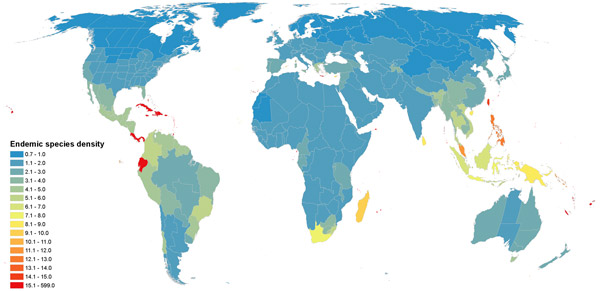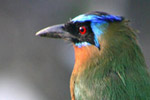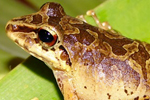In 2010 the Convention on Biological Diversity (CBD) pledged to set aside 17 percent of the world’s land as protected areas in addition to protecting 60 percent of the world’s plant species—through the Global Strategy for Plant Conservation (GSPC)—by 2020. Now a new study in Science finds that the world can achieve both ambitious goals at the same time—if only we protect the right places. Looking at data on over 100,000 flower plants, scientists determined that protecting 17 percent of the world’s land (focusing on priority plant areas) would conserve 67 percent of the world’s plants.
“To achieve these goals, we need to protect more land, on average, than we currently do, and much more in key places such as Madagascar, New Guinea and Ecuador,” explains co-author Stuart Pimm with Duke University and the NGO Saving Species. “Our study identifies regions of importance. The logical—and very challenging—next step will be to make tactical local decisions within those regions to secure the most critical land for conservation.”
The researchers scoured plant data from the Royal Botanic Gardens in Kew, England to find hotspots of endemic species, i.e. species regulated to a single location or region.
“Species endemic to small geographical ranges are at a much higher risk of being threatened or endangered than those with large ranges,” explains lead author Lucas Joppa at Cambridge.

Map shows endemic plant hotspots. Click to enlarge.
Not surprisingly, the priority areas identified for plant conservation start with many of the world’s islands, such as Caribbean, Pacific, and Mediterranean islands. Next come countries like Costa Rica, Panama, Ecuador, Taiwan, the Philippines, Papua New Guinea, Malaysia, Indonesia, Sri Lanka, Madagascar, and South Africa. Outside of national boundaries, the study also found important regions such as India’s Western Ghats, montane and coastal forests in East and West Africa, and southwestern Australia.
“We are not suggesting that we could protect all of these regions and nothing else, but this hypothetical 17% sets the bar for achieving [both the CBD goals],” the researchers write in the paper.
Targeting such areas would also go a long way toward protecting Earth’s animals.
“Our selected regions are important for terrestrial vertebrates. We find that 89% of bird species, 80% of amphibians, and 74% of mammals live within them,” the researchers note.
Currently, around 13 percent of the world’s land areas are under some form of protection, however, these protected areas have been created more along political lines than biodiversity ones.
“Present conservation efforts bias toward lands that are high, cold, dry, or otherwise far from people—often a mismatch with where conservation needs are pressing,” the researchers write.
If the 17 percent target set by the CBD will help maintain global biodiversity (and stem global extinctions overall—another goal of the CBD), conservationists and policy-makers will have to focus more on regions of high biodiversity and high endemism.

Researchers from the World Checklist of Selected Plant Families collecting plant species. Photo courtesy of Royal Botanic Gardens, Kew. Photo by: Charlie Fong.
CITATION: L. Joppa; P. Visconti; C.N. Jenkins; S.L. Pimm. Achieving the Convention on Biological Diversity’s Goals for Plant Conservation. Science. 2013.
Related articles
Ground zero for endangered species: new program to assist animals on the brink across Southeast Asia

(08/27/2013) Organizations within the international conservation community are joining forces to minimize impending extinctions in Southeast Asia, where habitat loss, trade and hunting have contributed to a dramatic decline in wildlife. The coalition is aptly named ASAP, or the Asian Species Action Partnership.
Trinidad and Tobago: a biodiversity hotspot overlooked

(08/26/2013) The two-island nation of Trinidad and Tobago in the Caribbean (just off the coast of Venezuela) may be smaller than Delaware, but it has had an outsized role in the history of rainforest conservation as well as our understanding of tropical ecology. Home to an astounding number of tropical ecosystems and over 3,000 species and counting (including 470 bird species in just 2,000 square miles), Trinidad and Tobago is an often overlooked gem in the world’s biodiversity.
New maps highlight global conservation priorities

(06/25/2013) What region of the world has the most imperiled mammals? Where are the most bird species found? And where are new amphibians being discovered? Indonesia and Malaysia is the answer to the first question; the Amazon, the second; and the Andes, the third. A new study in the Proceedings of the National Academy of Sciences (PNAS) has used global data on 21,000 mammals, birds, and amphibians to create magnificent maps that highlight missing priorities for conservation.
Difference within common species may predict the presence of rare animals
(06/05/2013) When deciding whether or not to clear a patch of rainforest land for development, scientists are often called in to quantify how many different species exist there. But determining the number of rare and threatened species living in a section of jungle isn’t easy. If they are very rare, the individual members of the species will be hard to find; if the area being surveyed is along a steep slope it may be difficult to access the area; if there are lots of species to identify, you might need to hire a dream team of biologists—each specialized within a different area of biodiversity—and that can get expensive. However a new study in the Proceedings of the Royal Society Journal by an international group of scientists suggests a more cost-effective and efficient way to rapidly assess local biodiversity.
Saving Gorongosa: E.O. Wilson on protecting a biodiversity hotspot in Mozambique

(05/30/2013) If you fly over the Great African Rift Valley from its northernmost point in Ethiopia, over the great national parks of Kenya and Tanzania, and follow it south to the very end, you will arrive at Gorongosa National Park in central Mozambique. Plateaus on the eastern and western sides of the park flank the lush valley in the center. Dramatic limestone cliffs, unexplored caves, wetlands, vast grasslands, rivers, lakes, and a patchwork of savanna and forest contribute to the incredible diversity of this park. What makes this place truly unique, however, is Mount Gorongosa—a towering massif that overlooks the valley below.
Wealthy nations, excluding U.S., pledge to double funds for biodiversity
(10/22/2012) Although negotiations came down to the wire, nations finally brokered a new deal at the 11th meeting of the Convention on Biological Diversity (CBD) in Hyderabad, India; at its heart is a pledge to double resources from wealthier countries to the developing world by 2015 to conserve embattled species and ecosystems. While no numbers were put on the table, observers say a doubling of current resources would mean around $10-12 billion a year. However, this amount is still far short of what scientists and conservation groups say is necessary to stem current extinctions.
India pledges over $60 million for biodiversity, but experts say much more needed
(10/18/2012) The Prime Minister of India, Manmohan Singh, pledged around $50 million (Rs. 264 crore) for domestic biodiversity protection, reports the Hindu. The pledge came this week at the Convention on Biological Diversity (CBD) meeting in Hyderabad, India. The CBD has set bold goals on stemming the rate of extinction worldwide, but these have suffered from a lack of funding. India also said it had set aside another $10 million (Rs. 50 crore) for biodiversity projects abroad. Still, such funds are far below what scientists say is necessary to stem ongoing extinctions.














